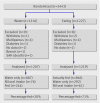Effect of food intake during labour on obstetric outcome: randomised controlled trial
- PMID: 19318702
- PMCID: PMC2660391
- DOI: 10.1136/bmj.b784
Effect of food intake during labour on obstetric outcome: randomised controlled trial
Abstract
Objective: To investigate the effect of feeding during labour on obstetric and neonatal outcomes.
Design: Prospective randomised controlled trial.
Setting: Birth centre in London teaching hospital.
Participants: 2426 nulliparous, non-diabetic women at term, with a singleton cephalic presenting fetus and in labour with a cervical dilatation of less than 6 cm.
Intervention: Consumption of a light diet or water during labour.
Main outcome measures: The primary outcome measure was spontaneous vaginal delivery rate. Other outcomes measured included duration of labour, need for augmentation of labour, instrumental and caesarean delivery rates, incidence of vomiting, and neonatal outcome.
Results: The spontaneous vaginal delivery rate was the same in both groups (44%; relative risk 0.99, 95% confidence interval 0.90 to 1.08). No clinically important differences were found in the duration of labour (geometric mean: eating, 597 min v water, 612 min; ratio of geometric means 0.98, 95% confidence interval 0.93 to 1.03), the caesarean delivery rate (30% v 30%; relative risk 0.99, 0.87 to 1.12), or the incidence of vomiting (35% v 34%; relative risk 1.05, 0.9 to 1.2). Neonatal outcomes were also similar.
Conclusions: Consumption of a light diet during labour did not influence obstetric or neonatal outcomes in participants, nor did it increase the incidence of vomiting. Women who are allowed to eat in labour have similar lengths of labour and operative delivery rates to those allowed water only.
Trial registration: Current Controlled Trials ISRCTN33298015.
Conflict of interest statement
Competing interests: None declared.
Figures
Comment in
-
Eating a light diet during labour.BMJ. 2009 Mar 24;338:b732. doi: 10.1136/bmj.b732. BMJ. 2009. PMID: 19318701 No abstract available.
References
-
- American Society of Anesthesiologist’s Task Force on Obstetric Anesthesia. Practice guidelines for obstetric anesthesia. Anesthesiology 2007;106:843-63. - PubMed
-
- Mendelson CL. The aspiration of stomach contents into the lungs during obstetric anesthesia. Am J Obstet Gynecol 1946;52:191-206. - PubMed
-
- Department of Health, Welsh Office, Scottish Home and Health Department, and Department of Health and Social Services, Northern Ireland. Report on confidential enquiries into maternal deaths in the United Kingdom 1988-1990. London: HMSO, 1994.
-
- Department of Health, Welsh Office, Scottish Home and Health Department, and Department of Health and Social Services, Northern Ireland. Report on confidential enquiries into maternal deaths in the United Kingdom 1991-1993. London: HMSO, 1996.
-
- Department of Health, Welsh Office, Scottish Home and Health Department, and Department of Health and Social Services, Northern Ireland. Report on confidential enquiries into maternal deaths in the United Kingdom 1994-1996. London: Stationery Office, 1998.
Publication types
MeSH terms
Associated data
LinkOut - more resources
Full Text Sources
Other Literature Sources
Medical

